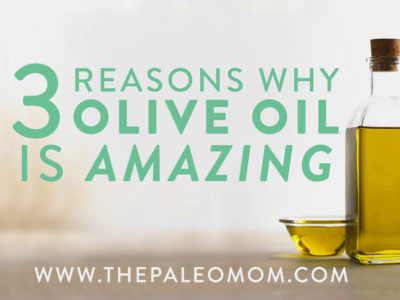Olive oil has been used for centuries and is simply one of the least controversial fats in use no matter what our nutritional philosophy might be. With endorsements from the Paleo, vegan, vegetarian, and low-calorie communities as well as the Harvard School of Public Health and the USDA, it’s one thing we can all agree on!
My favorite Olive Oil comes from Fresh Pressed Olive Oil, a home delivery service of ultra-premium, fresh-pressed, independently lab certified 100% extra virgin olive oil.
Read on to find out my top 3 reasons for LOVING olive oil!
1. Yes, you CAN cook with it!
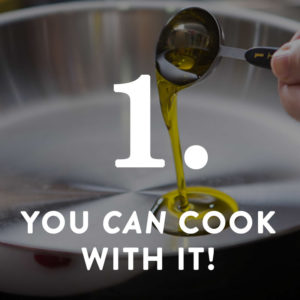 The verdict is in: high-quality olive oil (like Fresh Pressed Olive Oil) is a great fat for both cold and hot dishes! And that’s good news, because when you use a high-quality olive oil, it can add incredible Mediterranean flavor to any dish! Olive oil has long been touted as a cold-dish-only fat in the Paleo community because of its high heart-healthy monounsaturated fat content and approximately 10% polyunsaturated fat content, types of fat that are readily oxidized when heated which can lead to inflammation (see What About Fat? and Which Fats Should You Eat?).
The verdict is in: high-quality olive oil (like Fresh Pressed Olive Oil) is a great fat for both cold and hot dishes! And that’s good news, because when you use a high-quality olive oil, it can add incredible Mediterranean flavor to any dish! Olive oil has long been touted as a cold-dish-only fat in the Paleo community because of its high heart-healthy monounsaturated fat content and approximately 10% polyunsaturated fat content, types of fat that are readily oxidized when heated which can lead to inflammation (see What About Fat? and Which Fats Should You Eat?).
On the contrary, scientific studies have shown that extra virgin olive oil has to be heated for long periods of time (think 24 hours straight!) for heat to break it down enough to be harmful, and it is much more resistant to rancidity than other oils. The reason is due to extra virgin olive oil’s high content of antioxidants that protect the oil from damage in the face of heat or other oxidants. High-quality olive oils are very rich in at least 30 phenolic compounds with antioxidant activity—particularly oleuropein, hydroxytyrosol, tyrosol—as well as alpha-tocopherol, an important form of vitamin E. And, it turns out that good quality olive oil’s phenolic acid content helps stabilize vitamin E in the presence of heat, explaining why even sustained cooking times don’t destroy the oil’s nutritional value (see Olive Oil Redemption: Yes, It’s a Great Cooking Oil! ). So, we really don’t need to be afraid of using olive oil anymore: cooking with high-quality extra virgin olive oil is totally safe!
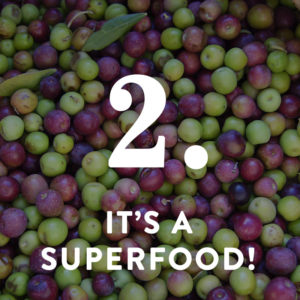 2. It really is a superfood fat!
2. It really is a superfood fat!
Countless research studies, mostly investigating the Mediterranean diet (which features very high olive oil consumption), have demonstrated olive oil to be cardioprotective, meaning that it helps to prevent cardiovascular disease by protecting the integrity of your vascular system (think healthy blood vessels) and lowering your dangerous LDL cholesterol (a marker of inflammation, too). Monounsaturated fats have also been linked with better blood sugar regulation, including lower fasting glucose (see What About Fat?, Portion Control: The Weight Loss Magic Bullet and Saturated Fat: Healthful, Harmful, or Somewhere in Between?). Beyond being a very healthy source of monounsaturated fats known , olive oil is rich in micronutrients and antioxidants that make it a totally awesome healing food.
In addition to its unique, cardioprotective fat content, olive oil is very rich in the vitamins E and K. Vitamin E is an important group of compounds that are most commonly noted for their antioxidant properties; other functions include acting as enzymatic cofactors and neuroprotective elements. Some have postulated that one of the reasons that olive oil should be consumed raw is that the vitamin E content will be reduced with cooking, but the science has shown that the nutrition in olive oil is fairly stable when cooked. One study also showed that, even after being heated, olive oil maintained most of its beneficial vitamin E content. Olive oil is also a very rich source of vitamin K1 or phylloquinone, which is the fat-soluble vitamin found in plants. Fun fact: vitamin K1 degrades with sunlight, so that is one of the reasons that olive oil is almost always found in dark green bottles. In the body, vitamin K1 is converted to the bioactive K2, which an important cofactor for coagulation factors (that help blood clot when necessary) as well as for maintaining appropriate calcium storage in bones. In addition to vitamins, olive oil contains large amounts of other antioxidants, including phenolics and carotenoids; these antioxidants help to explain its cardioprotective and anti-inflammatory properties as well as its ability to resist the oxidation that might otherwise happen during heating (see Polyphenols: Magic Bullet or Health Hype?).
However, it’s important to remember that all of these benefits are most potent when you choose a high-quality olive oil.
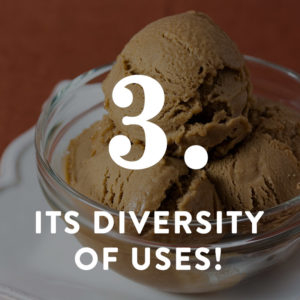 3. The diversity of recipes using olive oil is amazing!
3. The diversity of recipes using olive oil is amazing!
Okay, so olive oil is obviously a healthy addition to almost any diet! But, the icing on the cake is that olive oil is amazingly versatile and can be used in an unbelievable number of recipes. Before beginning a dish, make sure to opt for the best quality, extra virgin olive oil that you can find; “extra virgin” olive oil is the gold standard, because these are early-harvested olives that contain the most nutrition! My preference is Fresh Pressed Olive Oil for both the flavor and high polyphenol content. The key is to finding a high-quality olive oil is to read the label and look for extra virgin oil, not refined, with a harvest date (rather than a sell-by or expiry date) on the bottle. A high polyphenol content olive oil will leave a strongly peppery aftertaste at the back of your throat after you have a swig (yes, I regularly sample olive oil from the bottle after purchasing!). It’s also great to try to buy local, not 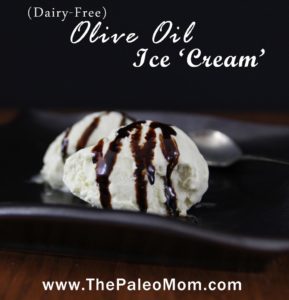 international. Once you have a favorite brand or two, you will be able to cook up a long list of versatile and delicious recipes! Here’s a surprising example: ever tried Olive Oil Ice Cream? With a high quality, flavorful extra virgin olive oil, you can make an ice cream that will change your life! Using olive oil for ice cream is actually common in Italy and with a simple recipe, an Ice Cream Maker, or a high power blender, you too can enjoy this delicious treat!
international. Once you have a favorite brand or two, you will be able to cook up a long list of versatile and delicious recipes! Here’s a surprising example: ever tried Olive Oil Ice Cream? With a high quality, flavorful extra virgin olive oil, you can make an ice cream that will change your life! Using olive oil for ice cream is actually common in Italy and with a simple recipe, an Ice Cream Maker, or a high power blender, you too can enjoy this delicious treat!
I feature olive oil in many of my recipes. Not only is it health-promoting and delicious, but it’s also AIP-friendly and a great solution when you want an oil that’s liquid even at lower temperatures (unlike solid fats.) You can substitute high-quality olive oil in pretty much any of my recipes that call for oil, but here’s a list of some of my favorite recipes featuring olive oil!
- Pulled Pork Wraps with Lime-Basil Pesto and Pickled Shallots
- Simple Fennel Salad
- Roasted Broccoli
- Citrus, Fig and Walnut Salad
- AIP Dinner Rolls
- Paleo Flour Tortillas
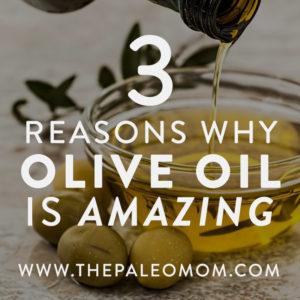 Citations
Citations
Allouche Y. “How heating affects extra virgin olive oil quality indexes and chemical composition.” J Agric Food Chem. 2007 Nov 14;55(23):9646-54.
Nutrivore Weekly Serving Matrix
An easy-to-use and flexible weekly checklist
to help you maximize nutrient-density.
The Weekly Serving Matrix is very helpful! I’ve been eating along these lines but this really helps me know where to focus vs. which foods serve a more secondary role. It’s super helpful and has taken a lot of worry out of my meal planning. Thanks!
Jan
Casal S, et al. “Olive oil stability under deep-frying conditions.” Food Chem Toxicol. 2010 Oct;48(10):2972-9.
Covas MI, et al. “The effect of polyphenols in olive oil on heart disease risk factors: a randomized trial.”Ann Intern Med. 2006 Sep 5;145(5):333-41.
Marrugat J. “Effects of differing phenolic content in dietary olive oils on lipids and LDL oxidation–a randomized controlled trial.” Eur J Nutr. 2004 Jun;43(3):140-7.
Pellegrini N. “Direct analysis of total antioxidant activity of olive oil and studies on the influence of heating.” J Agric Food Chem. 2001 May;49(5):2532-8.
Prabhu HR. “Lipid peroxidation in culinary oils subjected to thermal stress.” Indian J Clin Biochem. 2000 Aug;15(1):1-5.
Ramirez-Tortosa CM. “Extra-Virgin Olive Oil Increases the Resistance of LDL to Oxidation More than Refined Olive Oil in Free-Living Men with Peripheral Vascular Disease.” J. Nutr. December 1, 1999 vol. 129 no. 12, 2177-2183.
Staprãns I, et al. “Oxidized lipids in the diet are a source of oxidized lipid in chylomicrons of human serum.” Arterioscler Thromb. 1994 Dec;14(12):1900-5.
Tuck KL & Hayball PJ. “Major phenolic compounds in olive oil: metabolism and health effects.” J Nutr Biochem. 2002 Nov;13(11):636-644.
Visioli F. “Rusting the pipes: ingestion of oxidized lipids and vascular disease.” Vascul Pharmacol. 2014 Jul;62(1):47-8.

